Adroddiad sefyllfaol COVID-19: 5 Awst 2021
Diweddariad gan Gell Wybodaeth COVID-19 a'r Grŵp Ymgynghorol Diogelu Iechyd.
Efallai na fydd y ffeil hon yn gyfan gwbl hygyrch.
Ar y dudalen hon
Crynodeb yr adroddiad ar sefyllfa COVID-19
Y pwyntiau allweddol i’w nodi
O 7 Awst ymlaen, mae Cymru ar Lefel Rhybudd 0.
Mae trosglwyddiadau cyffredinol COVID-19 a phositifedd profion wedi gostwng ychydig ar draws Cymru. Mae amcangyfrif consensws y Gyd-ganolfan Bioddiogelwch (JBC) ar gyfer y rhif atgynhyrchu yng Nghymru rhwng 0.8 ac 1.1, tra bod amcangyfrif Iechyd Cyhoeddus Cymru (PHW) tua 0.85. Ffynhonnell: JBC / PHW (28/7/21). Sylwer bod fel arfer oedi o 2 i 3 wythnos yn amcangyfrif JBC a bod oedi yn achos amcangyfrif PHW, sy’n defnyddio methodoleg wahanol, o tua 1 wythnos. Sleid 3, Ffynhonnell: PHW.
Mae’r pwysau sydd ar y GIG oherwydd COVID-19 wedi bod yn cynyddu’n raddol dros yr wythnosau diwethaf, ond ymddengys bod y gwelyau llawn mewn unedau gofal dwys (ICU) yn gostwng ac nid oes sicrwydd ynghylch y tueddiad o ran gwelyau llawn mewn ysbytai. Mae’r pwysau sydd ar y GIG oherwydd COVID-19 wedi bod yn cynyddu’n gyffredinol dros yr wythnosau diwethaf. Fel yr oedd ar 4 Awst 2021, roedd 180 o gleifion sy’n gysylltiedig â COVID-19 (Amheuaeth, Cadarnhawyd, a oedd yn Gwella) yn defnyddio gwely mewn ysbyty. Mae hyn yn cymharu â 192 (12 yn llai o welyau yn cael eu defnyddio) ar 28 Gorffennaf 2021. Cleifion y cadarnhawyd bod ganddynt COVID-19 oedd yn defnyddio 131 o gyfanswm y gwelyau llawn mewn ysbytai, ac mae’r lefelau hyn yn debyg i’r hyn yr oeddent ddiwedd mis Mawrth 2021.
Fel yr oedd ar 3 Awst 2021, mae’r achosion a gadarnhawyd o’r amrywiolyn Delta, sef yr amrywiolyn amlycaf, yn 11,471 yng Nghymru (mae hyn yn gynnydd o 2,006 ers yr wythnos flaenorol). Canfuwyd 4 achos newydd hefyd o’r amrywiolyn Alffa, sy’n llai trosglwyddadwy, yr wythnos hon. Ni chanfuwyd unrhyw amrywiolyn sy’n peri pryder arall. Mae data ynghylch statws brechu yr achosion a derbyniadau i’r ysbyty yn cael eu diwygio gan Iechyd Cyhoeddus Cymru ar hyn o bryd felly nid ydynt ar gael. Ffynhonnell: PHW.
O ran brechu, ar 4 Awst 2021, mae cyfanswm o 4.39 (+0.06) miliwn o ddosau o frechlyn COVID-19 wedi cael eu rhoi yng Nghymru. O’r rhain, dosau cyntaf oedd 2.3 (+0.01) miliwn ac ail ddosau oedd 2.09 miliwn (+0.05). Yn seiliedig ar amcangyfrifon y Grŵp Cynghori ar Argyfyngau (SAGE), ei bod yn ofynnol bod o leiaf 80% o’r boblogaeth wedi’i brechu er mwyn ymateb i’r amrywiolyn Delta (gan gynnwys unigolion dan 18 oed), os na cheir unrhyw ymddygiadau amddiffynnol eraill, ni fydd y niferoedd presennol sydd wedi’u brechu yn diogelu ar lefel y boblogaeth gyfan. Mae’r Cyd-bwyllgor ar Imiwneiddio a Brechu (JCVI) wedi cymeradwyo’r dos cyntaf o frechlyn ar gyfer unigolion 16 a 17 oed yn y DU a bydd hyn yn dechrau yng Nghymru yn ystod yr wythnosau sydd i ddod. Ffynhonnell: PHW, SPI-M-O.
Dangosyddion allweddol
Mae nifer o ddangosyddion allweddol yn dangos gostyngiad, yn dilyn cyfnod o bythefnos cyn hyn pan gafwyd cynnydd.
Sylwer bod y saethau yn cynrychioli newid mewn cymhariaeth â’r wythnos ddiwethaf.
| Gwerth cyfredol (31/07/21) | Newid ers yr wythnos flaenorol (17/07/21 - 24/07/21 oni nodir fel arall) | ||||
|---|---|---|---|---|---|
| Newid mewn canran | Newid mewn gwerth | ||||
| Cyfradd yr achosion a gadarnhawyd (swm 7 diwrnod treigl fesul 100k) | 133 | -15% | ↓ | (-23) | |
| Cyfradd achosion a gadarnhawyd yn y rheini dros 60 oed (swm 7 diwrnod treigl fesul 100k) | 53 | -7% | ↓ | (-4) | |
| Positifedd profion (Cyfartaledd treigl 7 diwrnod) | 9.6% | -12% | ↓ | (-1.3 percentage points) | |
| Y boblogaeth yr amcangyfrifir bod ganddi COVID-19 (cyffredinrwydd)1 | 0.43% | -31% | ↑ | (-0.19 percentage points) | |
| Derbyniadau COVID-19 y GIG2 | 17 | -7% | ↓ | (-1) | |
| Marwolaethau ONS (swm 7 diwrnod)3 | 14 | +27% | ↑ | (+3) | |
| Marwolaethau PHW (swm 7 diwrnod) | 13 | +8% | ↑ | (+1) | |
- Mae’r data diweddaraf a gafwyd o’r Arolwg Heintiadau COVID-19 ar gyfer y cyfnod o 18 Gorffennaf 2021 i 24 Gorffennaf 2021.
- Y cyfartaledd treigl saith diwrnod hyd at y dyddiad presennol o gleifion y cadarnhawyd bod ganddynt COVID-19 – nid yw’n cynnwys cleifion y mae amheuaeth bod ganddynt COVID-19 neu sy’n gwella.
- Mae data marwolaethau diweddaraf ONS hyd at 23 Gorffennaf 2021 (yn hytrach na 31 Gorffennaf 2021) ar gyfer y gwerth cyfredol. Defnyddir data hyd at 16 Gorffennaf 2021 ar gyfer y newid ers yr wythnos flaenorol.
What is the current status of the epidemic?
| Local Authority | Health Board | Number | % of All Wales Total | Case Incidence per 100,000 | Change from previous week |
|---|---|---|---|---|---|
| Denbighshire | BCUHB | 344 | 8.00% | 359.5 | -15% ↓ |
| Conwy | BCUHB | 296 | 6.90% | 252.6 | -21% ↓ |
| Wrexham | BCUHB | 267 | 6.20% | 196.4 | -24% ↓ |
| Flintshire | BCUHB | 272 | 6.30% | 174.2 | -29% ↓ |
| Bridgend | CTMUHB | 245 | 5.70% | 166.6 | -19% ↓ |
| Powys | PTHB | 202 | 4.70% | 152.5 | -13% ↓ |
| Newport | ABUHB | 224 | 5.20% | 144.8 | 2% ↑ |
| Merthyr Tydfil | CTMUHB | 80 | 1.90% | 132.6 | -14% ↓ |
| Cardiff | CVUHB | 461 | 10.70% | 125.6 | -15% ↓ |
| Neath Port Talbot | SBUHB | 171 | 4.00% | 119.3 | 20% ↑ |
| Torfaen | ABUHB | 112 | 2.60% | 119.2 | -14% ↓ |
| Gwynedd | BCUHB | 147 | 3.40% | 118 | 26% ↑ |
| Swansea | SBUHB | 279 | 6.50% | 113 | -7% ↓ |
| Rhondda Cynon Taf | CTMUHB | 262 | 6.10% | 108.6 | -27% ↓ |
| Caerphilly | ABUHB | 196 | 4.60% | 108.2 | 0% → |
| Monmouthshire | ABUHB | 101 | 2.30% | 106.8 | -18% ↓ |
| Blaenau Gwent | ABUHB | 70 | 1.60% | 100.2 | 11% ↑ |
| Isle of Anglesey | BCUHB | 67 | 1.60% | 95.7 | -4% ↓ |
| Carmarthenshire | HDUHB | 168 | 3.90% | 89 | 14% ↑ |
| Ceredigion | HDUHB | 64 | 1.50% | 88 | -22% ↓ |
| Vale of Glamorgan | CVUHB | 112 | 2.60% | 83.8 | -26% ↓ |
| Pembrokeshire | HDUHB | 102 | 2.40% | 81.1 | -16% ↓ |
| Unknown | Unknown | 56 | 1.30% | - | 22% ↑ |
| Total | Total | 4298 | 100.00% | 136.3 | -13% ↓ |
At a Wales level, on 30 July 2021, the 7-day rolling incidence of COVID-19 cases has decreased since last week. The percentage of people testing positive for COVID-19 has remained steady since last week.
The JBC consensus estimate of Reproduction number (Rt) for Wales is between 0.8 and 1.1 (as at 5 August 2021), with daily growth rate of between –3% and +1% and a halving time of 29 days to flat. When we look at Rt using PHW positive test data only (see second table below), a more timely estimate but limited by variation in testing, we see an Rt of 0.85 for Wales and a national halving time of 65 days. When R is below 1.0, the pandemic is shrinking. Rt is highest for Swansea Bay health board at 1.0. PHW central estimates of halving times at health board level range from 34 to 265 days. Source: SAGE/ PHW.
7-day cumulative case incidence in Wales has decreased by an eighth in the last week. Case incidence has fell to 136.3 per 100,000 population in Wales compared with 156.9 per 100,000 population last week.
Case incidence is decreasing in almost all local authorities. Case incidence is above 100 per 100,000 population for 17 of the 22 local authorities. Local authorities with the highest case incidences are Denbighshire and Conwy at 359.5 and 252.6 per 100,000 population, respectively, although case incidence is decreasing in these areas. Case incidence is increasing for 5 of the local authorities.
Case incidence is highest in those aged 10 to 19 and 20 to 29. Case incidence has decreased throughout the last few weeks in these age groups. Case incidence is highest for the Betsi Cadwaladr health board. Case incidence is stable or decreasing in all health boards.
The second table below provides estimates of doubling and halving times based on PHW COVID-19 positive test data. In this table, doubling times are positive, whilst halving times are negative. The 95% confidence intervals are showing in brackets after the central estimate. An asterisk (*) means that there are small numbers and estimates should be treated with caution. Local health board level estimates of Rt and halving times will be unstable when incidence is low.
| Local Health Board | Rt (cases) | Halving time (days) |
|---|---|---|
| All Wales | 0.85 (0.8 to 0.9) | 64.7 (20.7 to –52.2) |
| Swansea Bay UHB | 1 (0.9 to 1.1) | 46 (18.0 to –83.7) DOUBLING |
| CTM UHB | 0.8 (0.7 to 0.85) | 21.4 (10.8 to 831.1) |
| Aneurin Bevan UHB | 0.95 (0.9 to1.0) | 264.6 (19.8 to –23.3) |
| Cardiff & Vale UHB | 0.8 (0.75 to 0.9) | 56.5 (17.6 to –46.7) |
| Hywel Dda UHB* | 0.9 (0.85 to 1.0) | 114.7 (16.8 to –23.8) DOUBLING |
| Powys THB* | 0.85 (0.75 to 0.95) | 143.5 (17.6 to –23.3) |
| Betsi Cadwaladr UHB | 0.8 (0.75 to 0.85) | 34.1 (15.6 to –178.2) |
Cases per 100k (PHW Data) (7 day rolling sum)
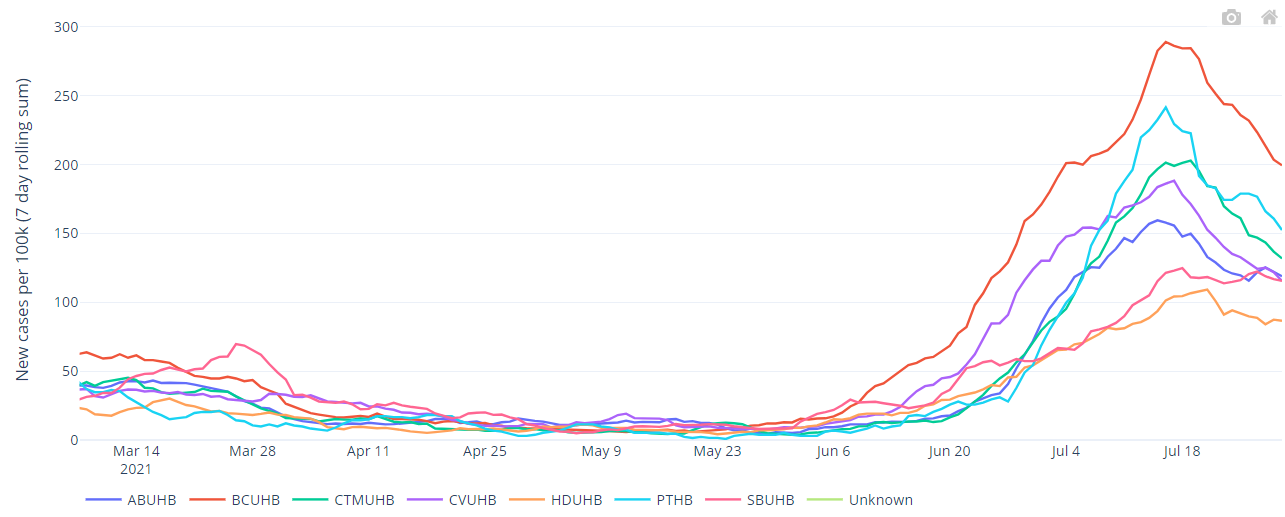
Cases per 100k by age (PHW Data) (7 day rolling sum)

Data as at 12:00PM 4 August 2021 unless otherwise specified.
What is the situation with the NHS and social care?
COVID-19 pressure on the NHS has been generally increasing over recent weeks. As at 4 August 2021, there were 180 COVID-19 related patients (Suspected, Confirmed and Recovering) occupying a hospital bed. This compares to 192 (12 fewer occupied beds) on 28 July 2021. Confirmed patients accounted for 131 of the total occupied beds, and are at similar levels to late March 2021.
There are 22 patients with Suspected or Confirmed COVID-19 in critical care beds in Wales. This is 142 lower than the maximum COVID-19 position of approximately 164. The total number of patients in critical care for both COVID-19 and non-COVID-19 stands at 156, 4 more than the historic maximum critical care capacity of approximately 152.
In the latest National Situation Background Assessment Recommendation (SBAR) report covering the week of 26 July 2021 to 1 August 2021, IMTs reported 113 care homes were in 'red' status (an ongoing outbreak/incident reported within the last 7 days), with 1 health board reporting having no care homes in 'red' status. This is compared with 91 care homes in 'red' status in the 7 days up to 25 July 2021. Source: National SBAR.
Confirmed hospital occupancy (7 day rolling average)

Overall invasive ventilated bed occupancy (7 day rolling average)
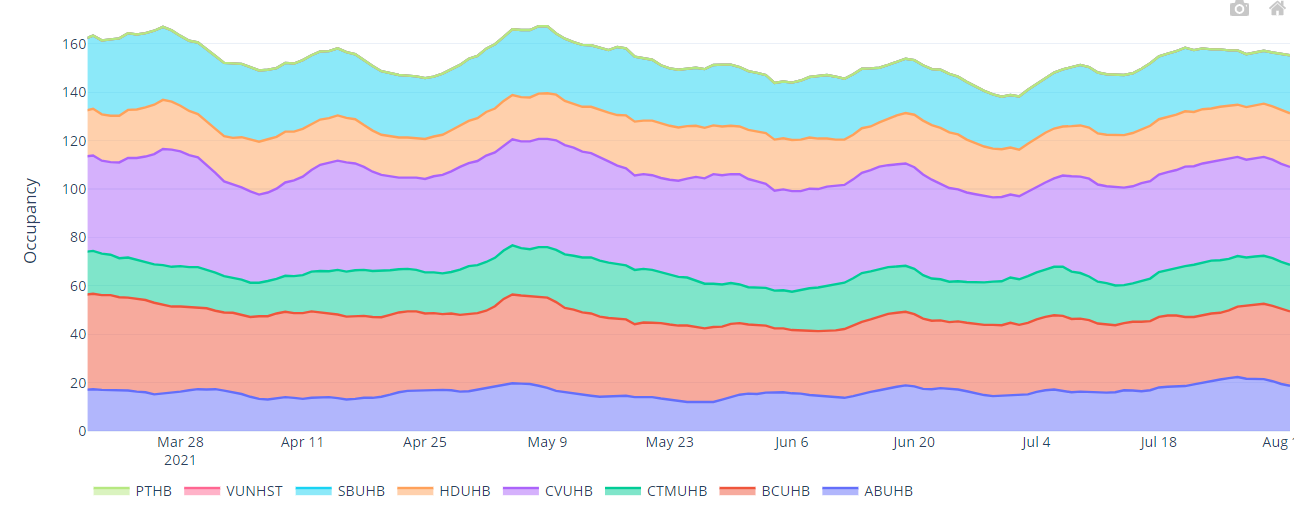
Hospital bed occupancy for suspected and confirmed COVID-19 positive patients (7 day rolling average)
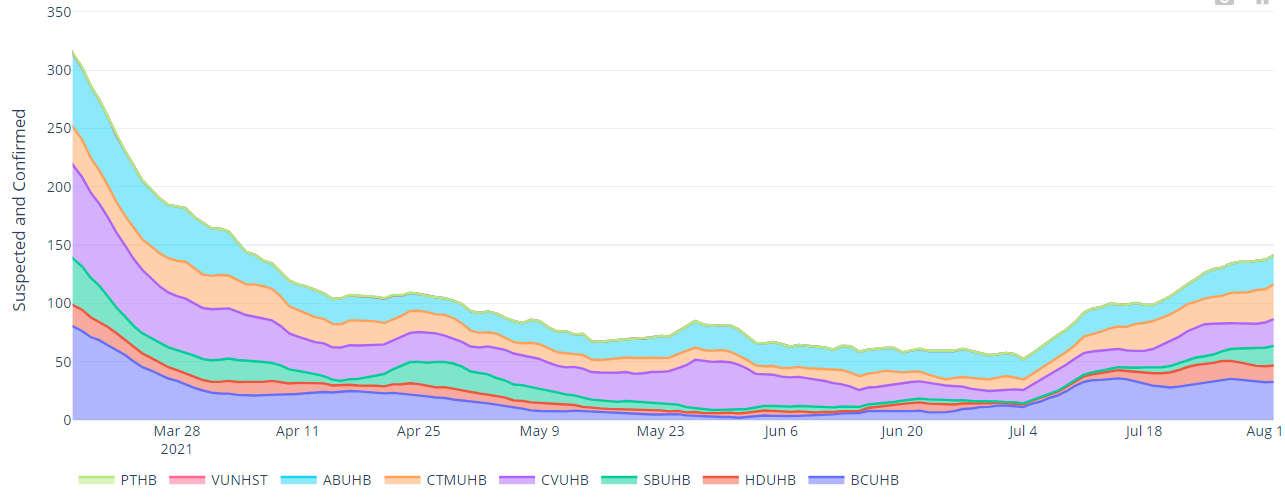
Invasive ventilated bed occupancy for suspected and confirmed COVID-19 positive patients (7 day rolling average)

Number of adult care homes reported an ongoing outbreak/incident (last 7 days)

What is the situation with education, children and young adults?
Childcare settings
The latest National Situation Background Assessment Recommendation (SBAR) report covering the week of 26 July to 1 August reported no new clusters in childcare settings last week, compared to 6 new clusters reported the previous week.
Schools
The number of new and ongoing school clusters has reduced significantly due to the end of summer term, however several IMTs have continued to report schools related clusters. There were 14* new and 46* ongoing clusters associated with schools reported by IMTs last week.
49* are attributed to school settings and 47* to household, social or extra-curricular activities. Source: National SBAR.
*Figures do not include Conwy or Cwm Taf Morgannwg data.
School reporting on hold
School reporting is on hold due to summer holidays. The available data is challenging to interpret, because a large proportion of staff and pupils are not in school.
Further Education (FE)
The latest National SBAR reported 1* new cluster was reported relating to FE settings last week, relating to a secondary school sixth form in Cardiff & Vale.
*This figure does not include data for Conwy or Cwm Taf Morgannwg.
Higher Education Institutions (HEIs)
According to the National SBAR, no new clusters have been reported by IMTs this week, though as with schools this is the summer holidays for HE settings. Source National SBAR
Whilst schools, FE and HE settings are closed for the summer, due to a lag in the data, IMTs are still able to report new clusters in these settings. They will also continue to monitor these, therefore we could have ongoing clusters that perhaps developed in the last week of the school term, being reported for a number of weeks.
What is the situation with arriving travellers
There is a 21% increase in overall travellers due to amber list arrivals. 87% of arrivals coming from amber countries. Positivity is approximately 0.89% which is marginally higher than the previous week. Amber list positivity has seen a small decrease.
Fully vaccinated travellers from EU and USA are no longer required to isolate. Arrivals from France are still required to isolate due to concerns over variants.
9,213 total travellers this week (7,621 last week):
- Red: 164 (167 last week)
- Amber: 8,011 (5,759 last week)
- Green: 982 (1,650 last week)

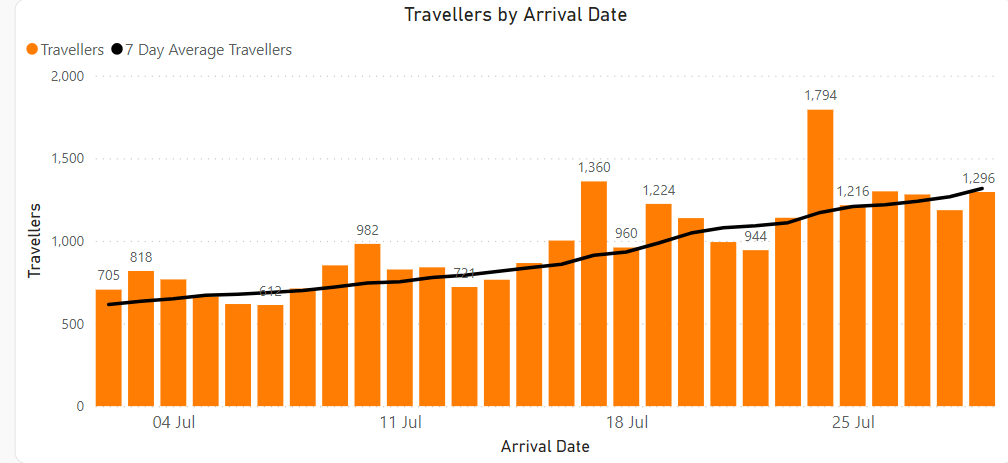
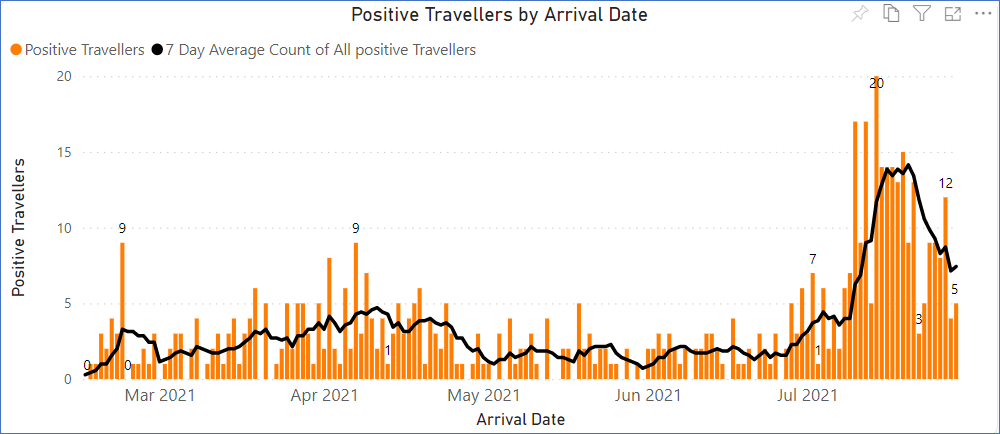
Source: Home Office
Please note that the data provided by the Home Office is derived from Passenger Locator Forms (PLF) which are self-completed by travellers. As such, data may contain inaccuracies. Due to the limitations associated with data capture and legislation, some minor discrepancies may be present in the data.
Mobility data, adherence and UK comparison
Mobility data by location of trip, Welsh local authorities
The latest mobility data shows a mixed picture with reductions in some categories compared to the previous week and some increases in people spending time at home. The baseline for much of the data is during January to February 2020 and changes are relative to that period. It is not possible to determine if mobility is higher/lower than would have been expected prior to the pandemic as data for 2019 or earlier years is not published.

Adherence
The most recent IPSOS MORI data for the period 16 – 19 July for Wales reports that perceptions of threat posed to the country by coronavirus has risen from 41% to 53%. Those only leaving home for essential journeys remained stable at 25%, lowest since the survey began in March 2020.
The latest results from the Public Engagement Survey on Health and Wellbeing during Coronavirus Measures (5 to 14 July) reports 85% of people said they understand current restrictions in Wales ‘very well’ or ‘fairly well’ and 37% of people said they were following coronavirus restrictions ‘completely’, down from 43% (21 – 27 June). It should be noted that this is self-reported adherence and will be affected by individuals’ understanding of the rules and circumstances that apply to them.
Results from the Coronavirus (COVID-19) Infection Survey, 18 July to 24 July
The percentage of people testing positive has decreased in England, Wales and Scotland. The percentage of people testing positive has increased in the most recent week in Northern Ireland.
It is estimated that an average of 13,000 people in Wales had COVID-19 (95% credible interval: 8,200 to 19,000), equating to around 1 in 230 people or 0.43% of the community population (down from 0.62% last week). This compares to around 1 in 75 people in England, around 1 in 120 people in Scotland, and around 1 in 55 people in Northern Ireland.
Source: Office for National Statistics COVID-19 Infection Survey.
Positivity rates (%) across UK countries up to 31 July 2021
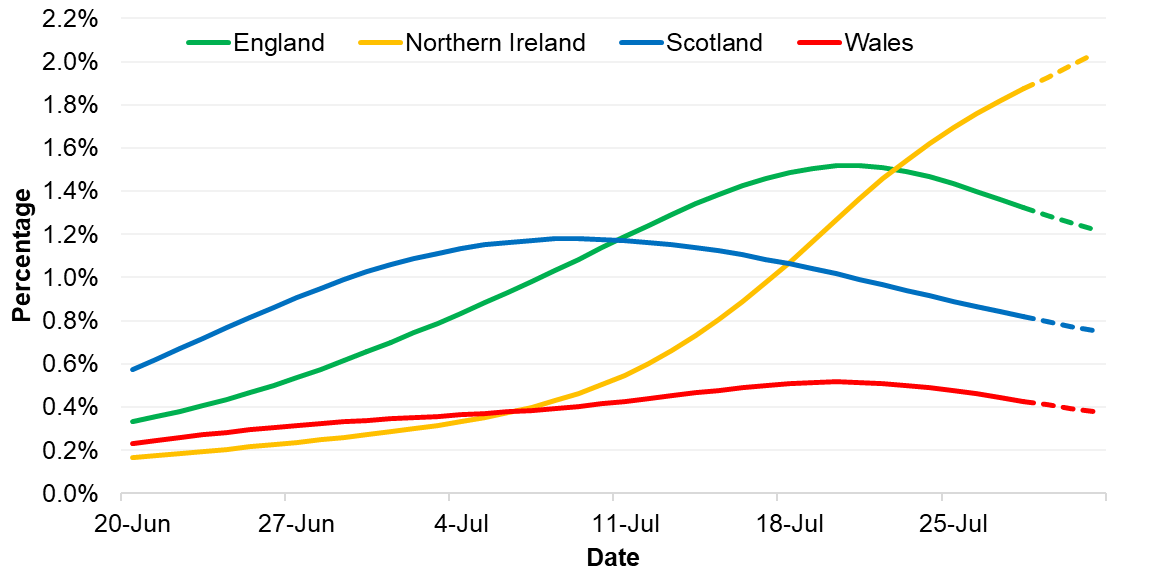
Vaccine and immunity status
Vaccination and antibody status of individuals aged 16 and over in Wales

Immunity estimates and antibody status of individuals aged 16 and over in Wales

The COVID-19 vaccination rollout of first doses has slowed in Wales, but rollout of second doses continues to progress well. As at 31 July 2021, 88% of people aged 16 and over had received at least one COVID-19 vaccine dose in Wales. 9% of people aged 16 and over had exactly one vaccine dose and 79% were fully vaccinated.
Between 12 and 18 July 2021, the ONS COVID-19 Infection Survey estimated that 93.2% of the community population aged 16 and over in Wales tested positive for COVID-19 antibodies.
As at 31 July 2021, it is estimated that 84% of people aged 16 and over in Wales had some immunity against COVID-19 infection. The lower and higher estimates of immunity are 65% and 85% of people aged 16 and over in Wales. If no vaccines had been administered, it is estimated that 37% of people aged 16 and over would be immune. These estimates assume 84% of natural infections lead to immunity, but do not account for waning immunity (SIREN study paper, The Lancet, published 9 April 2021).
It is currently estimated that over 80% (may be closer to 90%) of the population, spread evenly across Wales, must be immune to COVID-19 before population immunity effects would be observed (TAG advice on the Delta variant, published 18 June 2021). Note that the immunity estimate of 84% is for individuals aged 16 and over, not the total Wales population, and varies across age groups.
Differences between antibody presence and immunity estimates include:
- ONS antibody estimates are based on study participants who have volunteered for the study and estimates are extrapolated
- ONS estimates are based on the 16+ community population, which excludes people in care homes or hospitals. Immunity estimates are based on the whole 16+ Wales population
- While antibody protection doesn’t equal immunity from infection, it does give a useful indication of the level of protection from infection in the Welsh population.
- Antibody estimates use 2019 mid-year population estimates while we use 2020 estimates
Source: ONS COVID-19 Infection Survey, PHW, SPI-M, Swansea University modelling.
What does the situation look like going forward?
Based on the current rates observed with current restrictions:
Cases
The probability of incidence reaching greater than 200 per 100,000 between 8 August and 14 August is below 80% for all local authorities. The figure illustrates the probability (between 0 and 100%) of incidence being greater than 200 per 100,000. Source: Imperial College London.
Probability of greater than 100 per 100,000 cases by local authority

8 to 14 August and 15 to 21 August 2021
Deaths per day
SPI-M's consensus view is that the number of deaths in Wales will remain low compared with previous waves over the next three weeks. Source: Modelled medium term projections, SAGE/SPI-M, 28 July.
Number of deaths per day, Wales
Projecting forwards is difficult when numbers fall to very low levels, therefore SPI-M-O have decided to pause producing medium term projections where this is the case. SPI-M's consensus view is that the number of deaths in Wales will remain low over the next three weeks.
Hospitalisations per day
Projected to level off at around just over 20 per day over the next three weeks. Source: Modelled medium term projections, SAGE/SPI-M, 28 July.

These projections are based on current trends and will not fully reflect the impact of policy or behavioural changes over the past two to three weeks. The projections include the impact of vaccines, but cannot capture any future increases in transmission resulting from new variants. They are not forecasts or predictions.
Key risks and sources
Key risks
Transmissions, incidence and prevalence
Overall transmission, percentage of people testing positive is slightly decreasing since last week.
Trends vary across health boards and local authorities.
NHS Capacity
COVID-19 related patients in hospitals in Wales were continuing to increase and had reached levels similar to those in March 2021
Mortality
Low numbers of deaths in the most recent week, although is increasing.
Variants
Wales has 11,471 confirmed cases of the dominant Delta variant (an increase of 2,006 from the previous week) Delta remains the dominant variant of COVID-19 in Wales.
Immunity and vaccines
4.39 (+0.06) million doses of COVID-19 vaccine have been given in Wales, of which 2.3 (+0.01) million were first doses and 2.09 million (+0.05) were second doses.
International
There is an increase in travellers numbers this week, however positive rates are relatively low.
